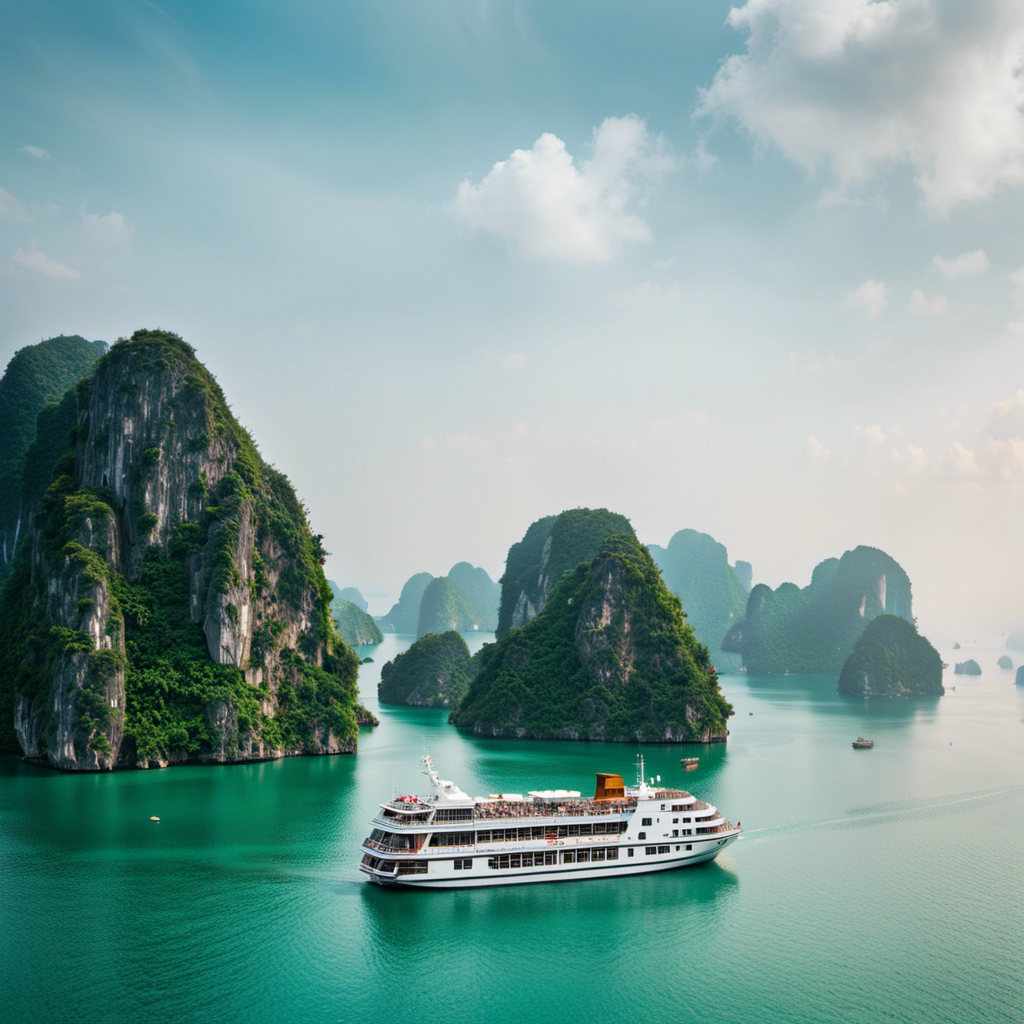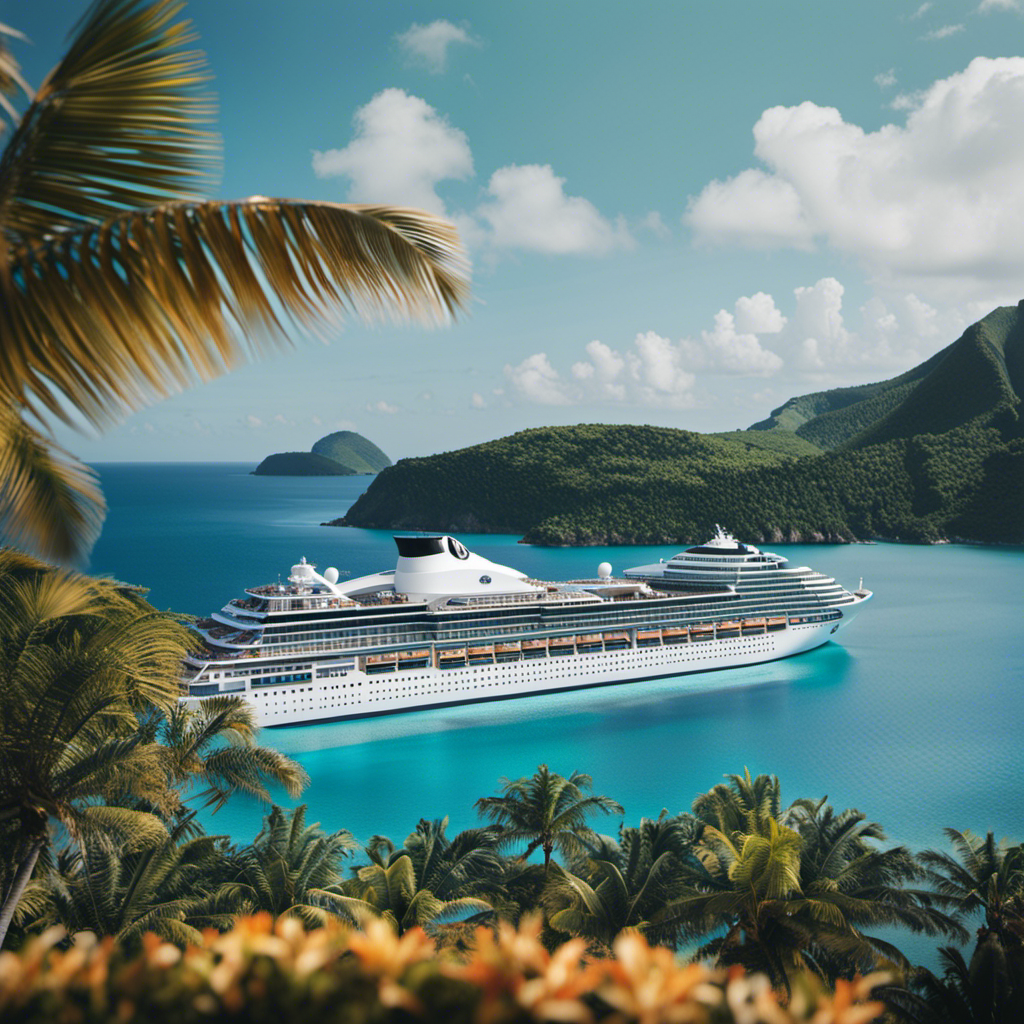It’s clear that the cruise sector in Asia is undergoing substantial expansion! Demonstrating an impressive expansion of 43% in ocean cruises and voyages throughout 2016, it’s evident that an increasing number of individuals are opting for maritime journeys in this area.
And who can blame them? With 60 ocean cruise ships and a projected passenger capacity of 3.2 million, there’s plenty of room to explore.
In this article, we’ll take a closer look at the growing Asia cruise industry and the exciting new destinations waiting to be discovered.
So grab your swim trunks and sunscreen, because we’re about to embark on an adventure like no other.
Key Takeaways
- The number of ocean cruises and voyages in Asia increased by 43% in 2016 compared to the previous year.
- Asian travelers experienced a 24% increase in ocean cruise passengers from 2014 to 2015.
- Chinese passengers grew at an annual compounded rate of 66% from 2012 to 2015, making China the world’s fastest-growing major source market for cruise passengers.
- Asian cruisers primarily explore Asian destinations, with 84% of cruises being within Asia.
The Rise of Asia Cruise Industry: A Closer Look
Looking at the information, it is clear that the rise of the Asia cruise industry is truly remarkable. Analyzing market growth patterns, it is evident that there are many new opportunities to be uncovered in this thriving industry.
The number of ocean cruises and voyages in Asia has increased by 43% in 2016 compared to the previous year. This growth is further highlighted by the fact that there will be 60 ocean cruise ships sailing in Asia this year, a 15% increase from 2013. The passenger capacity on these ships is also set to reach 3.2 million in 2016, reflecting a substantial 51% increase.
With over 204 destinations across 17 countries, the Asia cruise industry offers a wide range of exciting experiences for travelers. Japan, with its 1,526 port calls in 2016, stands as the biggest destination country.
This rise in the number of Asian cruise passengers is also noteworthy. From 2014 to 2015, there was a 24% increase in ocean cruise passengers from Asia. Chinese passengers, in particular, have experienced rapid growth, with a compounded annual rate of 66% from 2012 to 2015. In 2015, close to half of the Asian volume, or 986,000 passengers, were from mainland China, making China the world’s fastest growing major source market for cruise passengers.
Asian passengers also have a preference for shorter cruise lengths, with 30% choosing two to three night cruises. As for the destinations, Jeju Island in South Korea takes the lead with 460 calls in 2016. Other popular ports include Shanghai, Singapore, and Fukuoka.
Interestingly, Asian cruisers primarily explore Asian destinations, with 84% of them cruising within Asia. Only a small percentage, 3.6%, of Chinese travelers cruise outside of Asia. However, it is worth noting that some Asian passengers do fly to cruise destinations outside the region, particularly in Europe.
Demographically, the average age of cruisers in China is below 43, with 42% of them below 40 years old. In the region, 38% of all cruisers fall below the age of 40. To cater to Asian guests, cruise lines have tailored onboard offerings, such as multigenerational activities and regional cuisine. Asian cruisers also have a preference for high-end shopping and familiar favorites in menus. As a result, cruise lines have introduced high-tech features to attract Asian travelers.
The growth in cruise operations in Asia is also evident. The number of days cruise ships are in operation has increased from 4,307 in 2013 to 7,918 in 2016. Additionally, 12 cruise ships have extended their deployment in Asia this year. The capacity to carry passengers has surged by 51% in 2016.
While Asian outbound tourism is booming, Asian cruisers still primarily explore destinations within Asia. However, there has been a slight increase in the average length of their cruises, from 5.2 nights in 2014 to 5.3 nights in 2015.
Overall, the rise of the Asia cruise industry presents numerous opportunities for growth and the exploration of new destinations.
Unveiling the New Destinations in Asia Cruise Industry
I’ve just discovered some exciting additions to the cruise itineraries in Asia. The cruise industry in Asia is rapidly expanding, and with it, new ports and destinations are emerging. Here are the newest ports that are attracting cruisers in this booming market:
-
Nha Trang, Vietnam: This pristine coastal city is known for its beautiful beaches and vibrant culture. It offers a blend of natural beauty, historical sites, and delicious cuisine, making it a must-visit destination for cruise passengers.
-
Kota Kinabalu, Malaysia: Located on the island of Borneo, Kota Kinabalu is a gateway to exploring the incredible wildlife and natural wonders of the region. From the iconic Mount Kinabalu to the stunning coral reefs of the Tunku Abdul Rahman Marine Park, this port offers a diverse range of experiences.
-
Surabaya, Indonesia: As one of the largest cities in Indonesia, Surabaya is a bustling metropolis with a rich history and vibrant culture. From exploring its colonial-era architecture to visiting its traditional markets, this port provides a unique glimpse into Indonesian life.
These newest ports in Asia are attracting both cruisers and cruise lines, as they tap into the emerging markets and offer exciting experiences to passengers.
Exploring the Booming Cruise Market in Asia
The popularity of cruise travel in Asia continues to soar, attracting a surge of passengers and prompting the expansion of cruise operations in the region.
As the demand for cruising in Asia grows, cruise lines are responding by introducing their newest cruise ships to cater to the emerging Asian markets. These ships are equipped with state-of-the-art amenities and innovative features to provide an exceptional cruising experience.
With the emerging Asian markets, such as China and Japan, experiencing a significant increase in the number of cruise passengers, cruise lines are investing in expanding their operations in the region. This includes increasing the number of port calls and offering more itineraries to cater to the diverse preferences of Asian cruisers.
The booming cruise market in Asia is not only benefiting the cruise lines, but also contributing to the growth of the local economies in the region.
Asian Cruise Passengers: A Growing Trend
Passenger capacity on ocean cruise ships in Asia will reach 3.2 million in 2016, representing a 51% increase compared to previous years. This growth in capacity is a clear indication of the rising trend of Asian cruise passengers.
Asian travelers have shown a preference for shorter cruise lengths, with 30% opting for two to three night cruises. Chinese passengers, in particular, have experienced significant growth, with a compounded annual rate of 66% from 2012 to 2015. This presents great opportunities for the cruise industry to expand in Asia.
Cruise lines have tailored their offerings to cater to Asian guests, including multigenerational activities and regional cuisine. Additionally, high-tech features have been introduced to attract Asian travelers.
With the increase in capacity and the growing preferences of Asian cruise passengers, the cruise industry in Asia is poised for further expansion.
Must-Visit Asian Cruise Destinations
Shanghai, Singapore, and Fukuoka are popular Asian cruise ports with high numbers of calls. These destinations attract a large number of cruise ships due to their vibrant cultures, historical sites, and modern attractions.
However, there are also emerging cruise destinations in Asia that are gaining popularity among travelers. One such destination is Jeju Island in South Korea, which has seen a significant increase in port calls in recent years. Known for its stunning natural landscapes and UNESCO World Heritage sites, Jeju Island offers a unique and picturesque experience for cruise passengers.
Other emerging cruise destinations in Asia include Manila in the Philippines, Da Nang in Vietnam, and Kota Kinabalu in Malaysia. These destinations offer a mix of cultural, historical, and natural attractions, making them an exciting choice for cruise travelers looking to explore new and diverse destinations in Asia.
Demographics of Asian Cruisers: What You Need to Know
I find it fascinating to learn about the demographics of Asian cruisers and how cruise lines have tailored their offerings to cater to Asian guests.
One interesting aspect is the emphasis on multigenerational activities. Asian cruisers often travel with their families, and cruise lines have recognized this by providing a wide range of activities that can be enjoyed by all ages. From onboard water parks and sports facilities to interactive game shows and family-friendly entertainment, there is something for everyone to enjoy.
Another important aspect is the focus on regional cuisine. Asian passengers have a preference for familiar flavors and dishes from their home countries. Cruise lines have responded by incorporating regional cuisine into their menus, giving guests a taste of home while they sail the high seas.
It’s clear that cruise lines are making efforts to ensure that Asian guests feel at home and have a memorable cruising experience.
The Evolution of Cruise Operations in Asia
With the increasing popularity of cruising in Asia, cruise lines have expanded their operations and increased the number of days cruise ships are in operation. This evolution of cruise operations in Asia is a response to the growing demand from emerging markets in the region.
As the number of Asian passengers continues to rise, cruise lines are adapting their offerings to cater to the preferences of this market. They have introduced high-tech features, tailored onboard offerings, and regional cuisine to attract Asian travelers. Additionally, the capacity to carry passengers has surged by 51% in 2016, highlighting the industry’s commitment to meet the increasing demand.
These evolutionary changes in cruise operations in Asia are driven by the explosive growth of Asian outbound tourism and the preference of Asian cruisers to explore destinations within Asia.
Asian Outbound Tourism: A Catalyst for Cruise Industry Growth
Asian outbound tourism has significantly contributed to the growth of the cruise industry. The impact of cultural exchange on the growth of the Asian cruise industry cannot be underestimated.
As more Asians travel abroad, they are increasingly seeking unique experiences and opportunities to immerse themselves in different cultures. This has led to a surge in demand for cruises, as they offer the perfect platform for cultural exchange.
To attract more Asian millennials to the cruise industry, cruise lines have implemented various strategies.
Firstly, they have focused on creating onboard experiences that resonate with the younger generation, such as offering high-tech features and entertainment options.
Secondly, cruise lines have partnered with popular Asian influencers and celebrities to promote their offerings to the millennial market.
Lastly, they have developed itineraries that cater to the preferences and interests of Asian millennials, incorporating destinations and activities that appeal to this demographic.
Trends in Cruise Lengths: Insights From the Asian Market
Passengers in the Asian market are increasingly opting for shorter cruise lengths, with a preference for two to three night cruises. This trend reflects the changing cruise preferences of Asian travelers and highlights the market potential for shorter itineraries.
Here are four key insights into the cruise preferences of the Asian market:
-
Growing demand for shorter cruises: Asian passengers continue to show a preference for shorter cruise lengths, with 30% choosing two to three night cruises.
-
Market potential for shorter itineraries: The increasing demand for shorter cruises presents an opportunity for cruise lines to cater to the preferences of Asian travelers and tap into a potentially lucrative market segment.
-
Tailoring onboard offerings: Cruise lines have been tailoring their onboard offerings to cater to Asian guests, including multigenerational activities and regional cuisine, to enhance the cruise experience and meet the preferences of Asian cruisers.
-
High-tech features and familiar favorites: To attract Asian travelers, cruise lines have introduced high-tech features and incorporated familiar favorites in menus, such as high-end shopping and regional cuisine, to provide a personalized and enjoyable experience for Asian cruisers.
Understanding the cruise preferences of the Asian market is crucial for cruise lines to tap into the market potential and provide tailored experiences that cater to the preferences of Asian travelers.
Frequently Asked Questions
What Are Some Popular Asian Cruise Destinations Outside of Asia?
Some popular Asian cruise destinations outside of Asia include Europe, with Asian passengers flying to destinations like the Mediterranean. The Asian cruise market is expanding, and more travelers are exploring new and exciting destinations beyond their own region.
How Have Cruise Lines Tailored Their Onboard Offerings to Cater to Asian Guests?
Cruise lines have tailored their onboard offerings to cater to Asian guests by providing cultural entertainment and language services. This ensures that passengers feel more comfortable and can fully enjoy their cruise experience.
What Are Some of the High-Tech Features That Cruise Lines Have Introduced to Attract Asian Travelers?
Cruise lines have introduced high-tech entertainment and innovative dining experiences to attract Asian travelers. These features include virtual reality gaming, robot bartenders, interactive dining experiences, and smart technology in cabins.
How Has the Average Length of Cruises for Asian Passengers Changed Over the Years?
The average length of cruises for Asian passengers has slightly increased from 5.2 nights in 2014 to 5.3 nights in 2015. Factors influencing cruise length include passenger preferences, available destinations, and cruise line offerings.
What Are Some Factors Contributing to the Growth of the Cruise Industry in Asia?
Some factors contributing to the growth of the cruise industry in Asia include increasing number of ocean cruises, rising passenger capacity, and the preference of Asian travelers for shorter cruise lengths within Asia.
Claire, a creative soul with an unquenchable thirst for storytelling, is an integral part of the Voyager Info team. As a dedicated writer, she weaves captivating narratives that transport readers to enchanting cruise destinations and beyond.
Claire’s love affair with writing began at an early age when she discovered the magic of words and their ability to craft worlds and emotions. Her innate curiosity led her to explore various literary genres, but it was travel writing that truly captured her heart. Drawing inspiration from her own globetrotting adventures and encounters with diverse cultures, Claire embarked on a journey to become a travel writer par excellence.











